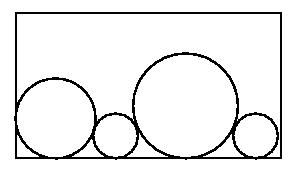Ian's going to California, and he has to pack his things, including his
collection of circles. Given a set of circles, your program must
find the smallest rectangular box in which they fit.
All circles must touch the bottom of the box. The figure below shows
an acceptable packing for a set of circles (although this may not be
the optimal packing for these particular circles). Note that in an
ideal packing, each circle should touch at least one other circle
(but you probably figured that out).
The first line of input contains a single positive decimal integer n,
n<50. This indicates the number of lines which follow. The
subsequent n lines each contain a series of numbers separated by
spaces. The first number on each of these lines is a positive integer
m, m<8, which indicates how many other numbers appear on that
line. The next m numbers on the line are the radii of the circles
which must be packed in a single box. These numbers need not be
integers.
For each data line of input, excluding the first line of input containing
n, your program must output the size of the smallest rectangle which can
pack the circles. Each case should be output on a separate line by itself,
with three places after the decimal point. Do not output leading zeroes
unless the number is less than 1, e.g. 0.543.
3
3 2.0 1.0 2.0
4 2.0 2.0 2.0 2.0
3 2.0 1.0 4.0
9.657
16.000
12.657
Miguel Revilla
2000-08-22

